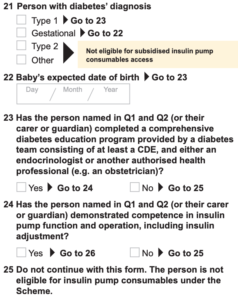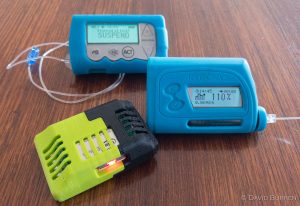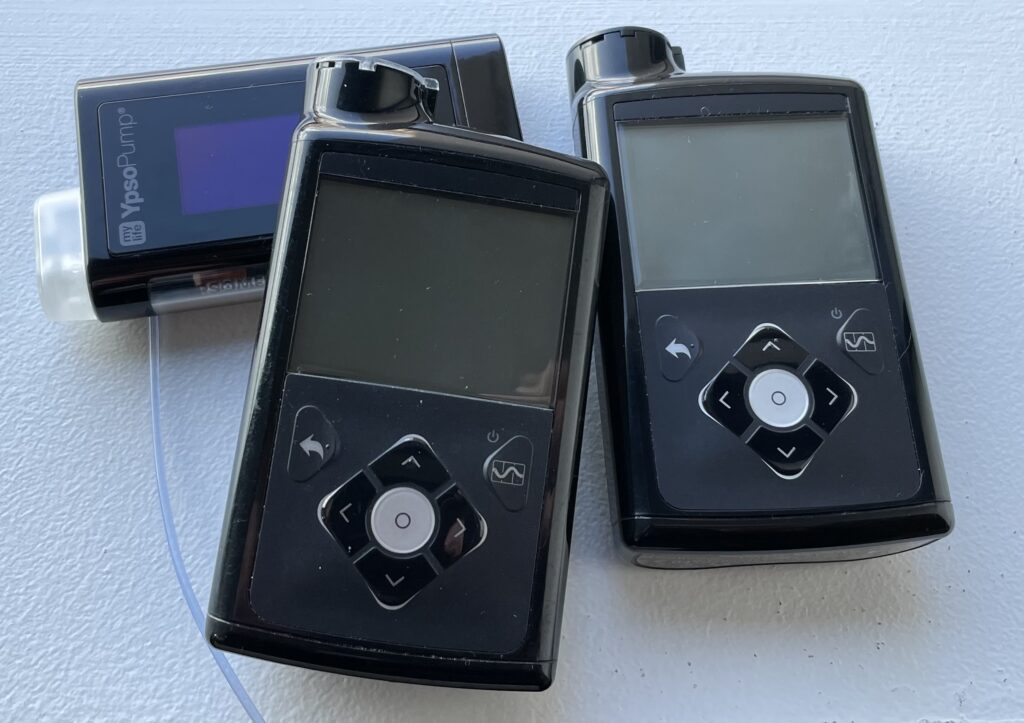This is often a contentious topic. But I’ll try to bring some clarity to the discussion.
Starting with an insulin pump
The traditional path in Australia for people to start with a pump involves getting private health insurance to pay for a new pump (which then comes with 4 years of warranty) and work with a diabetes educator and often an endocrinologist to get the education and paperwork done. See my Insulin Pump Choices article for a current list of pumps in use (as well as others not yet available).
There are a few important things that happen along the way, and one of these is you get your NDSS status upgraded to give access to subsidised pump consumables. This is done via the completion of NDSS’s Insulin Pump Consumable Access Form. Without this you would have to pay a lot for reservoirs and infusion sets. I estimate our monthly cost (on the order of $30 for many people) would go up by at least a factor of 10).
 It’s worth noting Q24 on that form. The HCP completing the form has to attest that you have “demonstrated competence in insulin pump function and operation, including insulin adjustment”.
It’s worth noting Q24 on that form. The HCP completing the form has to attest that you have “demonstrated competence in insulin pump function and operation, including insulin adjustment”.
It obviously gives everyone peace of mind with a new pump that there’s a company standing behind it with training materials and technical support (including replacement if something’s not working). But what happens with a second-hand pump?
But before we get to starting pumping with a second-hand pump, it’s worth going over the whole topic of trading pumps!
Can you buy/sell/trade insulin pumps?
I do have to preface this with a reminder that I Am Not A Lawyer. But I do understand that in Australia yes this is legal. I (and others) have specifically checked with the TGA.
To provide a pump, it needs to be an approved device (a model on the TGA’s ARTG) and not have been modified. For example you can buy an unapproved pump from overseas (that would fall under “personal importation”) and use it yourself, but you could not provide it to someone else. But if you have an approved device, you’re free to provide it to someone else for their use.
Keep in mind that a pump is not a sterile device. The consumables (reservoirs and infusion sets) are sterile when packaged by the manufacturer, but the pump itself does not touch the insulin. So there should be no risk of infection/etc from using a second-hand pump.
Of course you need to be sure you’ve programmed it to match your needs, but that should be obvious.
In short: yes it is apparently legal to trade pumps.
What about the insurance company?
Some people think that because they received their pump through insurance then it belongs to the insurer, or they otherwise have some “hold” over it. It doesn’t seem to work that way. When your insurer buys a pump for you, that is then your pump. Essentially you “paid” for it (through your past and forecast premiums).
Before they bought it for you they evaluated the conditions and decided to go ahead. One of those conditions is that you’ve passed the mandatory 12-month waiting period for pre-existing conditions. Also usually that it’s been at least 4 years since the last time they bought you one (with some companies it’s unfortunately 5 years). But I believe an appropriate phrase is probably that “their pecuniary interest in the pump ends when you’ve received it”.
Of course, if you then decide you want your insurer to buy you another pump before that period is up, you’d need to fight with them and prove it was needed rather than the one you “currently have”. In some cases this has been successful due to documentation of clinical need.
Anyone who got a pump through insurance, sold it then asked for a new one early might attract the interest of fraud investigators. But there are plenty of documented cases of people finding that they wanted to change away from the pump, so stopping using the pump and even selling it are not unknown. Let’s loop back to that statement about them having no pecuniary interest in the pump.
So yes, it happens
Plenty of second-hand insulin pumps are given/donated/sold to other people within Australia. But even that’s not the end of the story.
What happens with warranty?
It’s important to note that when someone buys a pump they’re partly buying the pump itself, and partly buying the next 4 years of warranty support. Those are not separated as line items on a bill: they come together. But the terms of that warranty are usually that it’s provided to the original purchaser. That is: the warranty can’t be on-sold to someone else.
It’s worth keeping that in mind if you’re considering a second-hand pump and how much money you would pay for it. Brand-new the same pump might cost you between $7000-8600, but it would be hard to argue that that sort of money would be appropriate for a pump without warranty.
If an out-of-warranty pump developed a fault that would normally be solved by replacement, that would not be an option. You’d have a very expensive “brick” on your hands.
Many people are capable of resolving minor issues with using their pumps by themselves, while some like to use the tech support line to deal with everything related to the pump. You would simply have no access to that resource, and for some people that would be an issue.
But for problems with the pump itself there’s little substitute for actual warranty support, and with a second-hand pump you do not get that. In reality the odds of ever having such a problem can be quite small, but when it does happen you need to be prepared for the lack of warranty.
So why would someone want a second-hand pump?
Not everyone is going to be comfortable using a second-hand pump, and that’s fine. but there are many reasons why people decide it’s worthwhile for them. I can think of a few scenarios:
Because you can’t afford a new pump
 Some people can’t afford the premiums to get a pump covered by insurance. But they decide that they need one to improve their health and diabetes management.
Some people can’t afford the premiums to get a pump covered by insurance. But they decide that they need one to improve their health and diabetes management.
And those people are probably unlikely to be able to afford buying a new pump outright.
To have a backup device for your in-warranty pump

For instance I’ve done a lot of remote travel, and I like to have a backup pump to take with me. I’ve often been in locations where it would take weeks for a replacement pump to reach me (if it could at all). After a device failure it’s so much easier to live through the remainder of the trip with a working pump rather than having to change my life back to having to work with injections.
Some companies will provide loan units for this purpose, but those aren’t always available (especially for extended periods). It’s reassuring to have your own backup unit available any time you need it.
It’s also worth noting that even at home sometimes delivery of a replacement pump can take days.
To have a backup for your main pump
If your pump has no warranty, you can reduce your risk exposure by having two of them!
That might be because you’ve had to cancel your health insurance and your original pump has passed out of its warranty period. Or it might be because your other pump was a second-hand unit in the first place…
Because you can’t get the pump model you need as new
 One example would be a “loopable” pump such as a Combo or an old Medtronic. It’s not just that the particular model might be unavailable: it might be that your insurer isn’t ready to buy you a new pump yet!
One example would be a “loopable” pump such as a Combo or an old Medtronic. It’s not just that the particular model might be unavailable: it might be that your insurer isn’t ready to buy you a new pump yet!
Overall I think there can be lots of valid reasons for getting a second-hand pump, and certainly hundreds of people have done it. It’s not going to suit everyone, and that’s fine too.
HCP involvement if you get a second-hand pump
Obviously your health care professionals are not involved in your purchase, but depending on a few things they may need to know about it. So let’s explore two scenarios:
Getting a second-hand pump once you’re already pumping
Once you’re registered with NDSS for pump access, you remain eligible. You don’t need to re-register for each pump (even if you change brand).
So a backup pump doesn’t even need to be the same brand/model. But obviously it’s more convenient when packing for travel if it can share some of the consumables you’ve packed for your normal pump.
There is always something new to learn with a new model pump, whether you’re taught that by a DE or you learn it by reading the manual and watching the manufacturer’s training videos (DEs can’t teach you everything anyway). But the fundamental knowledge/skills from your original pump underpin that, and your medical team don’t need to fill out a new IPC access form saying you’ve been re-trained.
Starting with a second-hand pump
This is where we return to the starting point of this article. Situations such as where someone without access to health insurance or the ability to buy one new, but who want/need to start pumping. There are many people who have managed to do start with a second-hand pump, but there are also people who have been stymied by their doctors.
Consider that NDSS IPC access form that your doctor/DE needs to sign their name to. It’s understandable that they might not be comfortable with what they perceive as the risks to you by using a pump that has no warranty. But hopefully they would be comfortable signing off on both:
- Q23: “[have] completed a comprehensive diabetes education program provided team consisting of at least a CDE, and either an endocrinologist or another authorised health professional”
- Q24: “[have] demonstrated competence in insulin pump function and operation, including insulin adjustment”
I would hope that there would be recognition that such competence would involve you accepting the risk of having no warranty and being prepared to deal with lack of a pump in the event of failure. After all, it’s you who has to live with the pump day-to-day.
Some doctors have not been comfortable supporting their patients to start using a pump without warranty. But (especially with demonstrated competence by the patient) many doctors have been comfortable in supporting their patients to live better lives.
How much should I pay?
I’m particularly not going to explore this topic here. The condition of the particular pump, how old it is, how popular that model is: these all come into play. But do remember that a re-sold pump has no warranty by default.
I’ve certainly been involved in distributing many donated pumps at no cost (think of it as the community looking after each other). So I’ve lived in a world where we didn’t put price expectations on old pumps we weren’t using any more.
But hopefully this exploration of second-hand pump use helps inform people of some of the issues involved!

